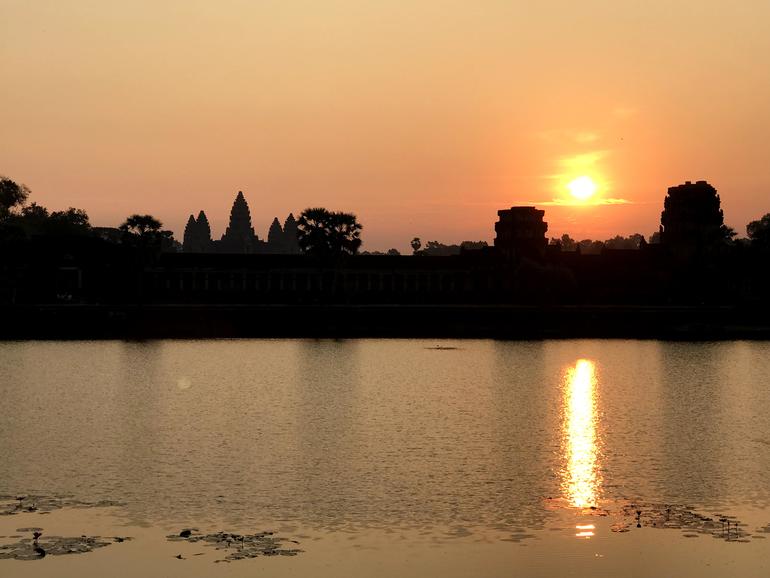
Sunrise over Angkor Archaeological Park in Siem Reap, Cambodia.
World Monuments Fund’s Cambodian Team
Since our first expedition to Cambodia in 1989, World Monuments Fund has engaged in conservation initiatives at five sites within Angkor Archaeological Park: Neak Pean, Angkor Wat, Preah Khan, Ta Som, and Phnom Bakheng. I visited all five during my visit and came away profoundly moved by the legacy of conservation excellence and commitment to community that World Monuments Fund has established here.
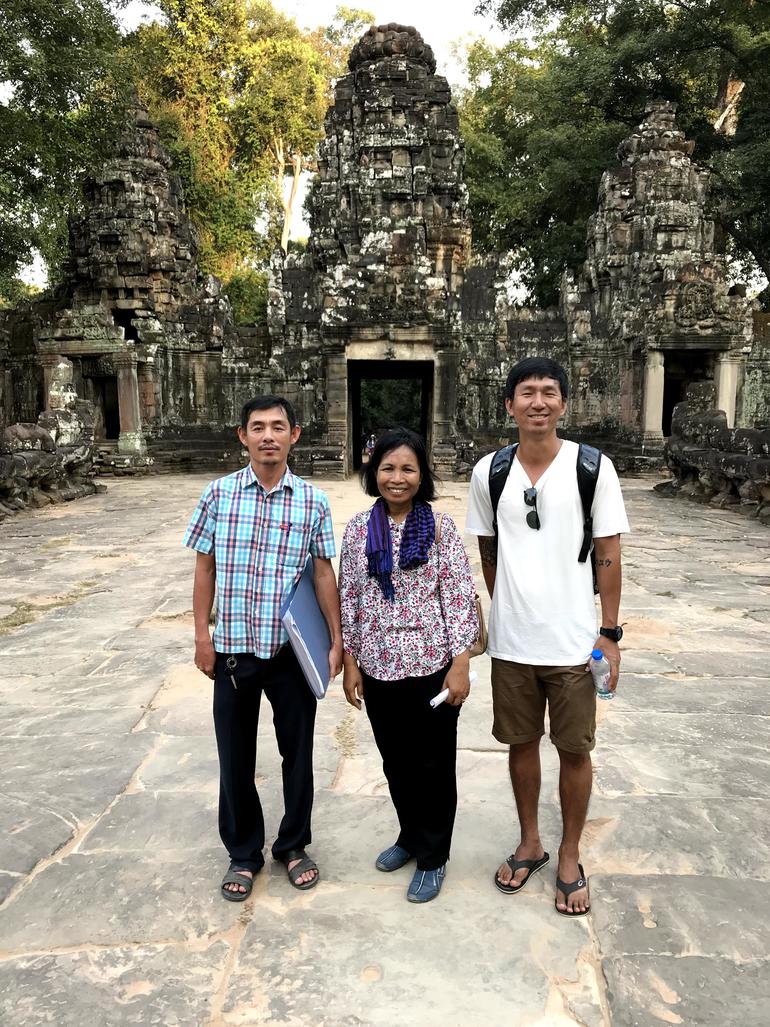
(L to R) Phirum Chiv, Phally Cheam, and Bunwat Hun, in front of Preah Khan.
My guides in Cambodia were Phally Cheam, Senior Architect, Bunwat Hun, Architect, and Phirum Chiv, Engineer. If you’ve been fortunate enough to meet these leaders of our local team, you know how personable and knowledgeable they are, and how deeply they are respected by the colleagues they manage.
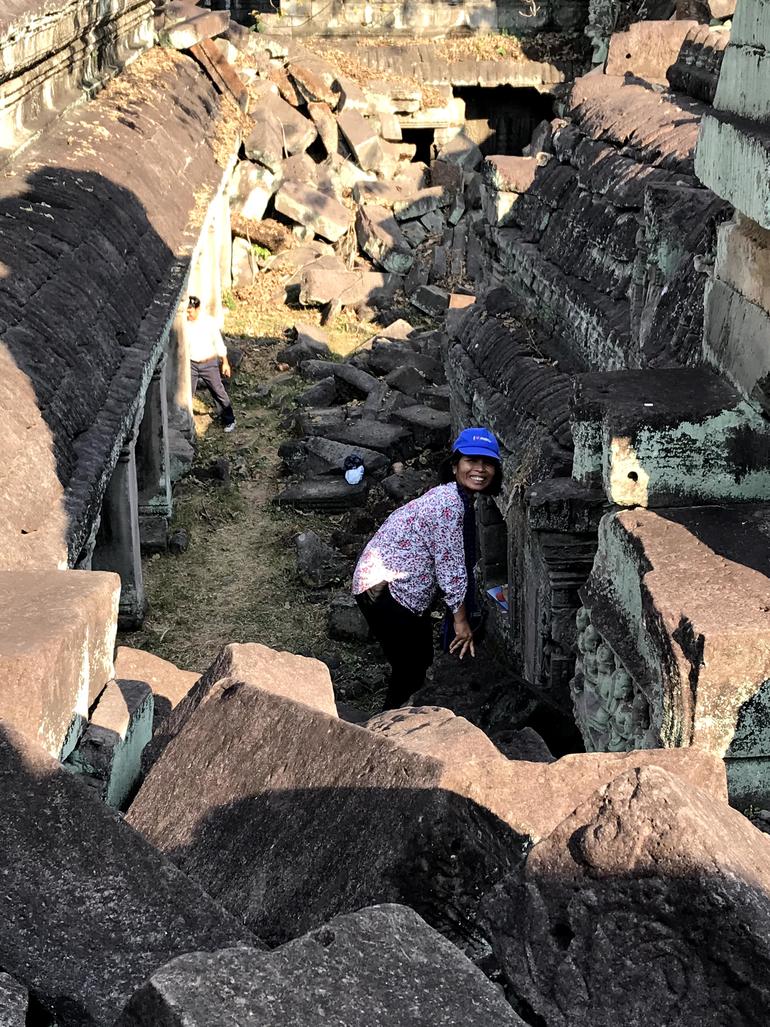
Phally Cheam among the ruins at Preah Khan.
Phally’s path to leadership at Angkor is an inspiring story. Following the Khmer Rouge genocide and years of guerilla warfare, the sites of ancient Angkor had been swallowed by jungle, studded with landmines, and deprived of professional care. In 1991, with the ranks of Cambodia’s artists, intellectuals, and professionals decimated, the first post-war class of architects graduated from the Royal University of Fine Arts, in Phnom Penh, and Phally was among them.
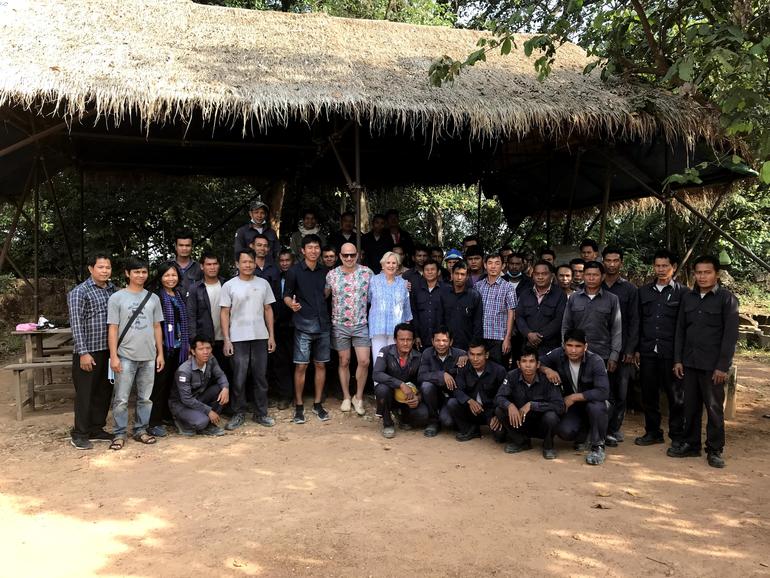
The team of workers at Preah Khan with Joshua David and WMF chair Lorna Goodman, center.
Phally joined one of our earliest conservation teams, at a time when we were bringing experts from around the world to Angkor to frame a sensitive conservation approach to its centuries-old Khmer sites. After 27 years of commitment to World Monuments Fund and its work at Angkor, she now manages a corps of over 100 Cambodian skilled workers, almost all of whom live within the archaeological park itself or its immediate surroundings.
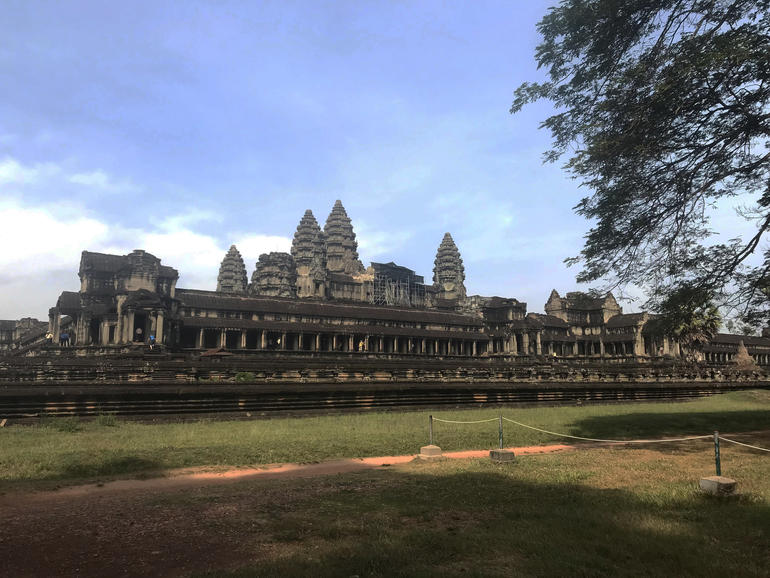
Angkor Wat and the Churning of the Sea of Milk Gallery.
Our Work at Angkor Today
Each Cambodian site at which World Monuments Fund has worked tells a different story of our deliberative, innovative, and often quite ambitious approach to the sustainable stewardship of these iconic places. At Angkor Wat, for instance, our careful disassembly, conservation, and reassembly of the corbelled stone roof of the Churning of the Sea of Milk Gallery, a triumph of research, analysis, and engineering, was an essential contribution to the long-term well-being of the most famous, most visited site in the region and its treasured bas-relief wall carvings.
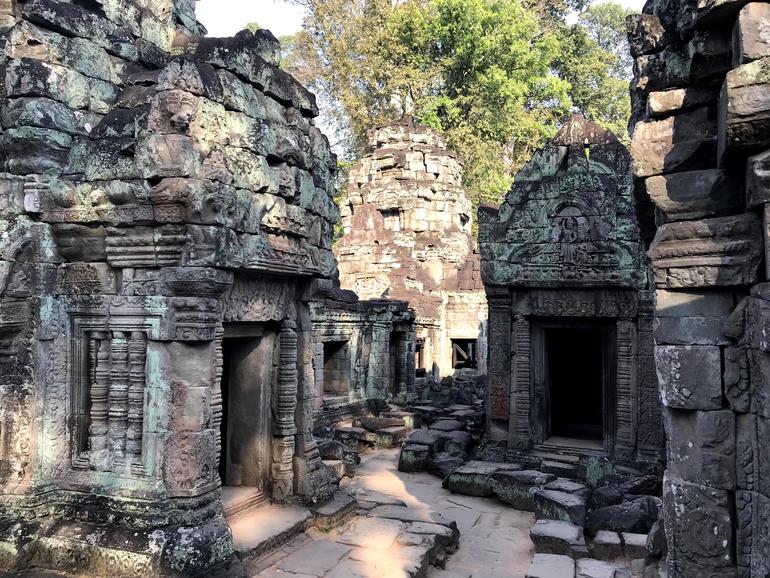
Shiva complex near north entrance of Preah Khan.
The full span of our Cambodian legacy, meanwhile, is powerfully illustrated by a visit to the first major site we worked at in Angkor—Preah Khan— and a visit to the one at which we are most deeply engaged in conservation today, Phnom Bakheng.
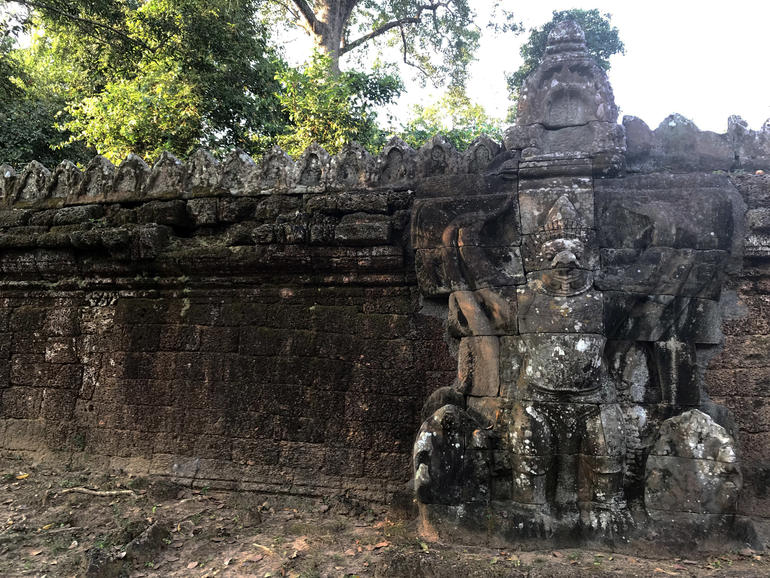
Garudas stand guard over Preah Khan.
Preah Khan: Sustaining a Ruin’s Romance
Millions of people now visit Angkor Archaeological Park annually, bringing crowds to its most famous sites. But even during peak season, a late afternoon walk through the monastic complex of Preah Khan remains a contemplative experience. The low sun sets the sandstone aglow, while crying monkeys and birdcalls peal through a jungle that presses from all sides.
Preah Khan was built by King Jayavarman VII (1181-1218), with four concentric enclosures divided by intersecting east-west and north-south axes and 515 shrines radiating from the inner sanctum, all surrounded by walls where 72 garuda guardians stand as sentries.
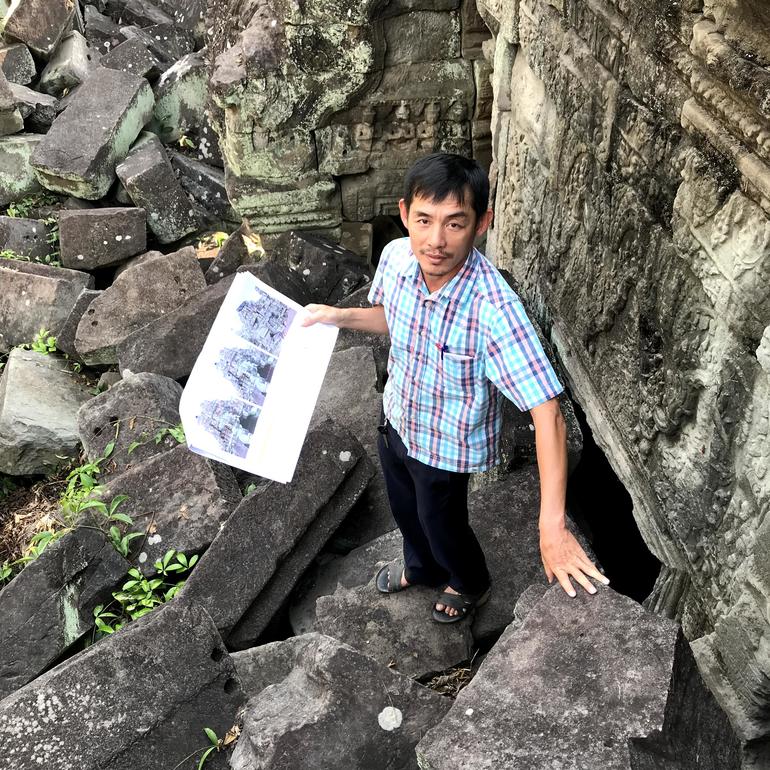
Engineer Phirum Chiv among the ruins at Preah Khan.
During World Monuments Fund’s first fact-finding mission to Angkor in 1989, our team set their focus on Preah Khan as its first project. Its jungle setting steeped it in mystery, and the challenges of the low-lying site were simpler than those of temple-mountains such as Angkor Wat. World Monuments Fund’s then-vice president of field projects, John Stubbs, and consulting architect John Sanday, developed an approach that focused on training a new generation of local caretakers while conserving the site much as it was found, as a stabilized ruin.
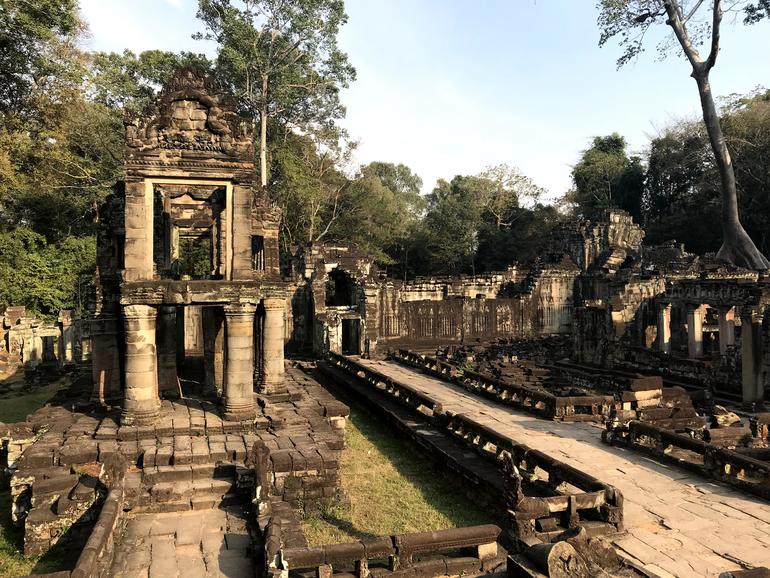
Preah Khan's unique two-story pavilion.
The success of this approach defines any visit to the site today. Many of the biggest hurdles have been passed: releasing the site from the clutches of the jungle; clearing and making accessible most of the east-west and north-south axes; and stabilizing the Hall of Dancers near its unusual two-story pavilion. Now our local Cambodian team regularly monitors the site to identify areas of need and develop conservation plans to ensure the site’s long-term integrity.
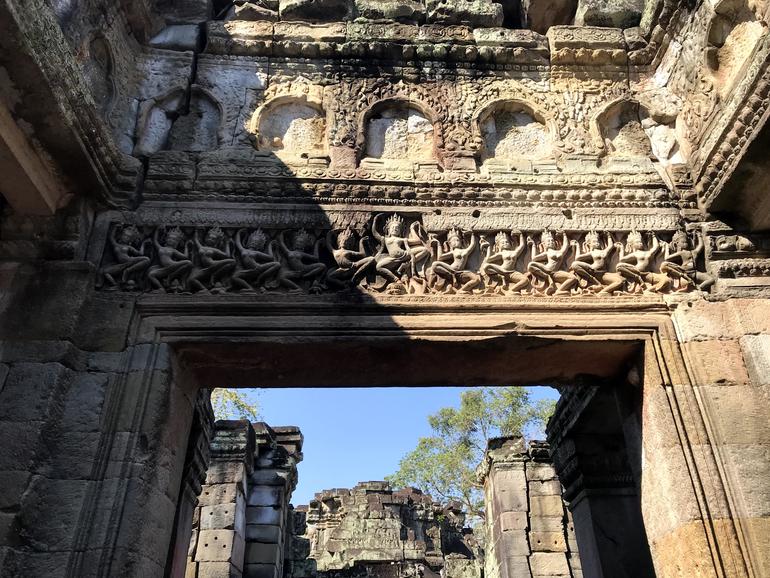
Hall of Dancers bas relief at Preah Khan.
Hall of Dancers bas relief at Preah Khan.
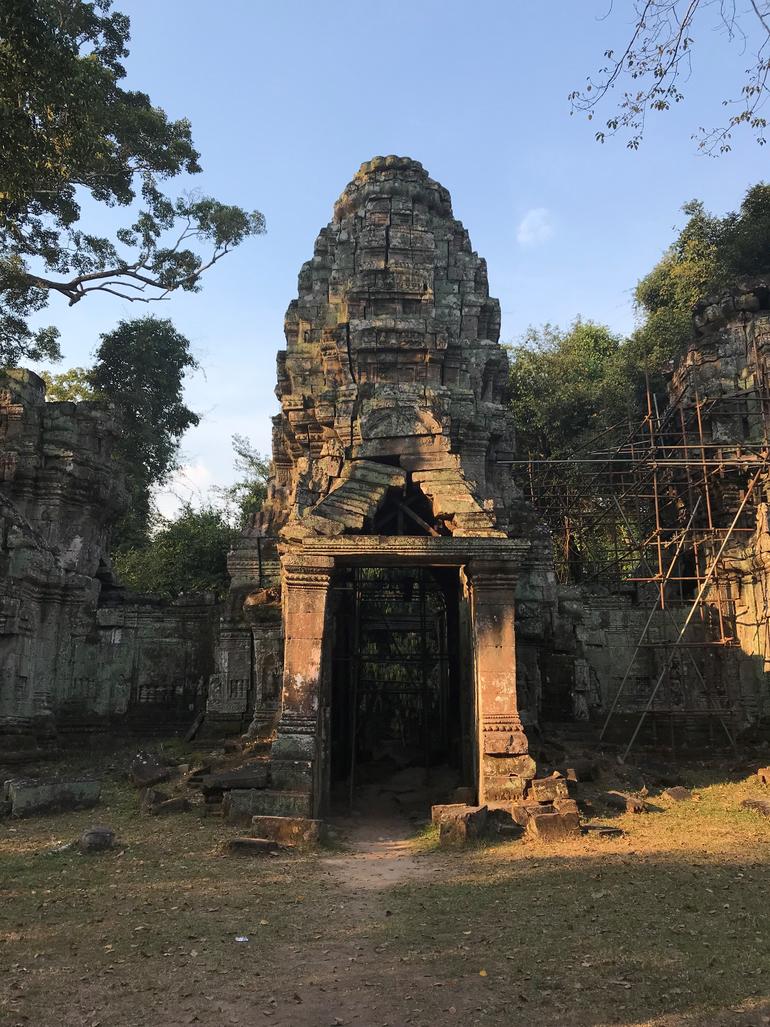
The secluded South Gopura IV at Preah Khan.
On my visit, Phally, Bunwat, and Phirum led me through several current projects: rebuilding our popular interpretation center, and stabilizing doorways, lintels, towers, and passageways throughout the complex. These are modest projects compared to some that were undertaken in years past, but all are in keeping with the gentle touch World Monuments Fund has always brought to Preah Khan.
In some places, our work is located along well-used visitor pathways, such as the stone lintel repairs to be undertaken near North Gopura III. Other projects lie in parts of the complex that are less visited, such as the towers near South Gopura IV, a side of the complex as secluded and beguiling today as it would have been to early modern explorers when they first researched the site so many years ago.
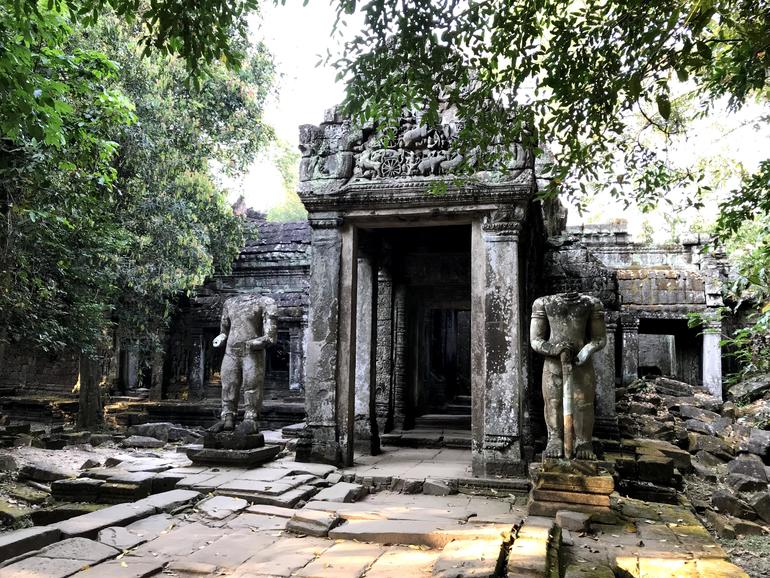
South entrance to Preah Khan.
One comes away from an afternoon at Preah Khan marveling at the thoughtfulness of the planning that underpins World Monuments Fund’s conservation work, the care with which those plans are being carried out, and the beauty of the site itself. For those who have followed the project since its early days, it’s a testament to the vision of past WMF president Bonnie Burnham and the team she built and led here. For those seeing it for the first time, its helps you understand the astounding record of achievement of World Monuments Fund.
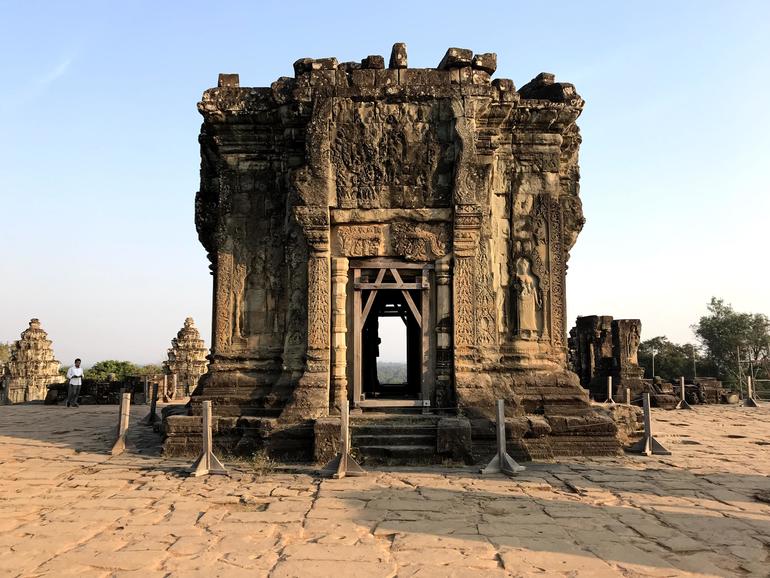
Central shrine atop Phnom Bakheng.
Phnom Bakheng: A feat of conservation engineering
With the arrival of scores of workers on motorbikes, the constant whir of stone sanders, the persistent tapping of chisels, and the slow swing of the crane, lowering monumental blocks of sandstone into place, your first moments at the work site at Phnom Bakheng instantly convey the scope of the endeavor that World Monuments Fund has undertaken.
Starting in 2004, World Monuments Fund approached the needs of Phnom Bakheng with the same diligent study and analysis that they did at Preah Khan and other sites. What they discovered was a vulnerable hilltop temple with unique structural challenges, one that ultimately demanded a complex and ambitious conservation approach.
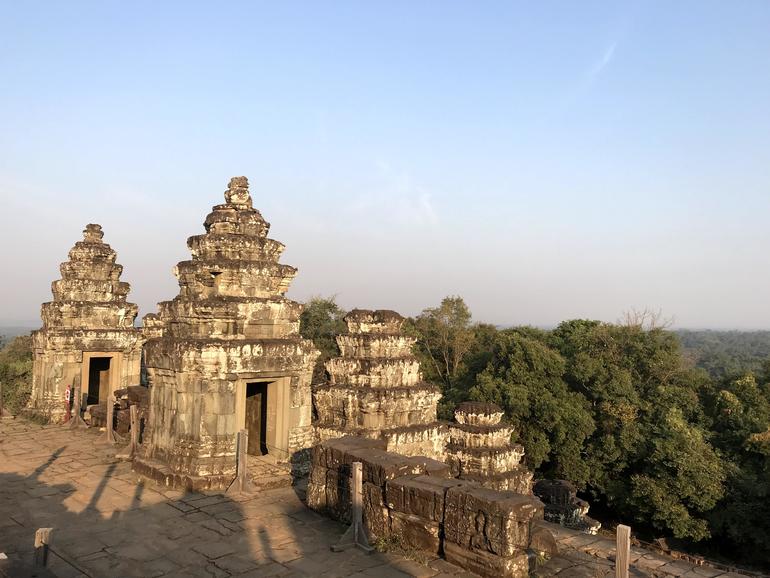
Stone shrines dot Phnom Bakheng.
Phnom Bakheng is the oldest major site at Angkor Archaeological Park. Completed in the tenth century, it’s the temple around which the ancient city was first organized when King Yasovarman I moved the Khmer capital to this region. A five-level pyramid with stone shrines dotting its walls, it was built by augmenting the hilltop with laterite foundations and cladding the terraces with blocks and pavers of sandstone. Over the passing centuries, water has continually seeped through gaps between the sandstone blocks, eroding the pyramid from within, leading to wall collapses and undermining the shrines. The site has also been impacted by crowds of visitors who flocked to the hilltop at sunset, clambering over the crumbling walls.
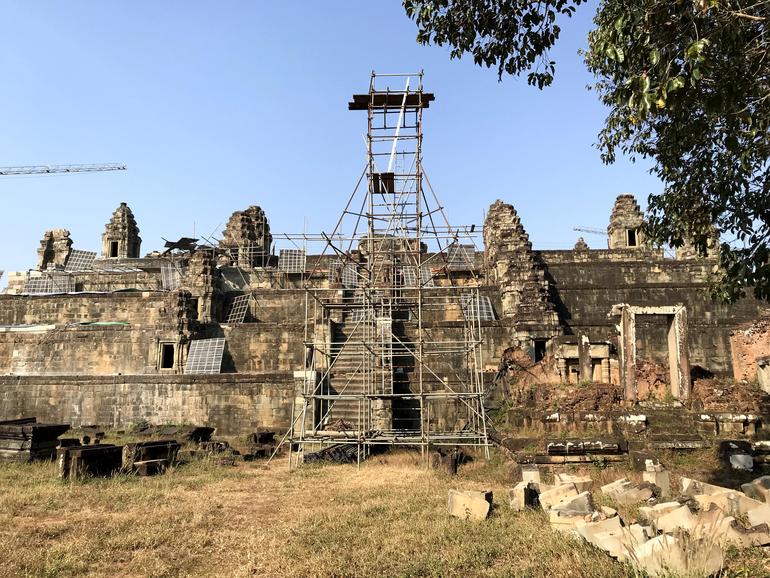
Eastern side of Phnom Bakheng, currently under restoration.
World Monuments Fund began its work in 2004 with condition assessments and documentation, leading to a conservation master plan. A new site management program was developed, reorganizing entry to the site and limiting access to the top of the pyramid to no more than 300 people at any time.
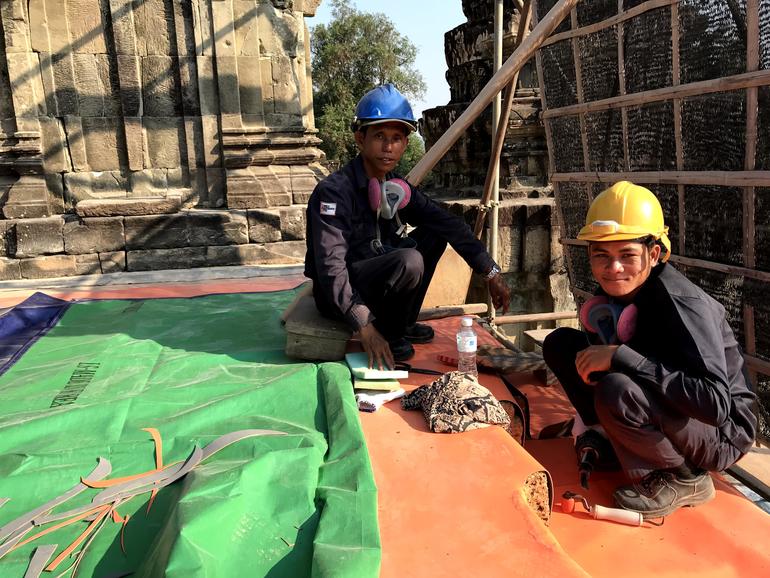
Installing the waterproof membrane in Phnom Bakheng.
Addressing the structural issues required an intense, artfully engineered intervention—one that is monitored and evaluated by international experts at regular milestones. Across the eastern half of the pyramid, the sandstone wall blocks and pavers are being disassembled, along with the sanctuaries that sit atop them; laterite foundations underneath are then restored; a waterproof membrane is installed; and finally the pyramid walls are reassembled and the pavers reset on top. Whenever possible, original stones are replaced in their original positions, supplemented by stones found where they fell, or others that have been removed to the perimeters of the site over time.
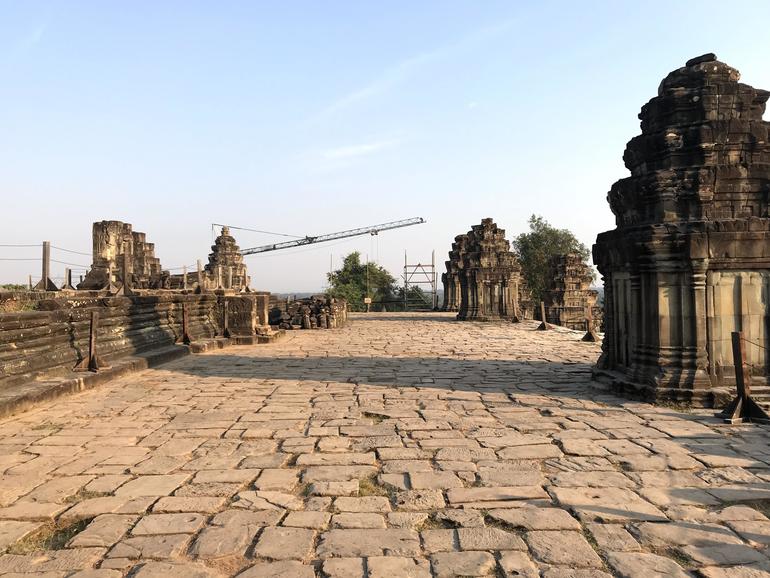
A WMF crane in the distance, surrounded by stone shrines, atop Phnom Bakheng.
A WMF crane in the distance, surrounded by stone shrines, atop Phnom Bakheng.
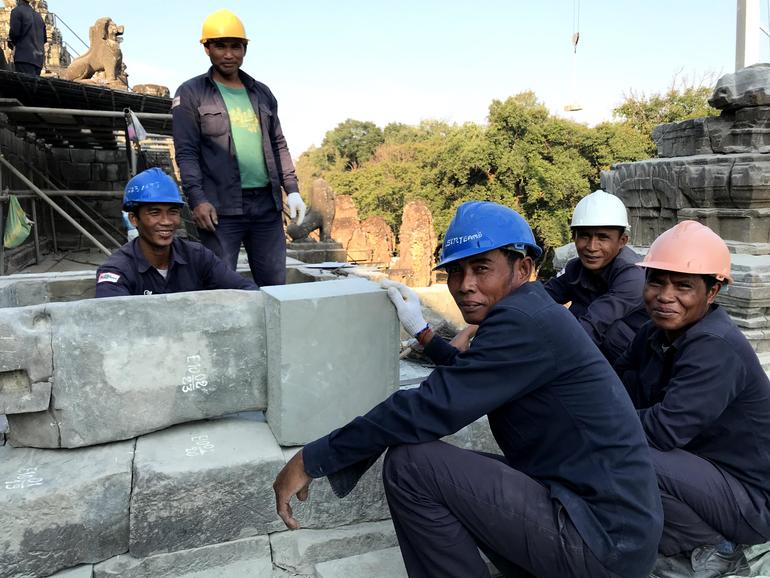
Workers at Phnom Bakheng rebuild stone shrines after waterproofing.
To visit the site today is to see a massive undertaking, executed by a crew that is working at an exemplary level of care. Whether chiseling a millimeter of sandstone from a block to ensure its fit, cutting the waterproof membrane and blowtorching its seam, or grinding down pavers to create a level, textured surface, our skilled workers continually elevate this enormous mission through their attention to hundreds of tiny details.
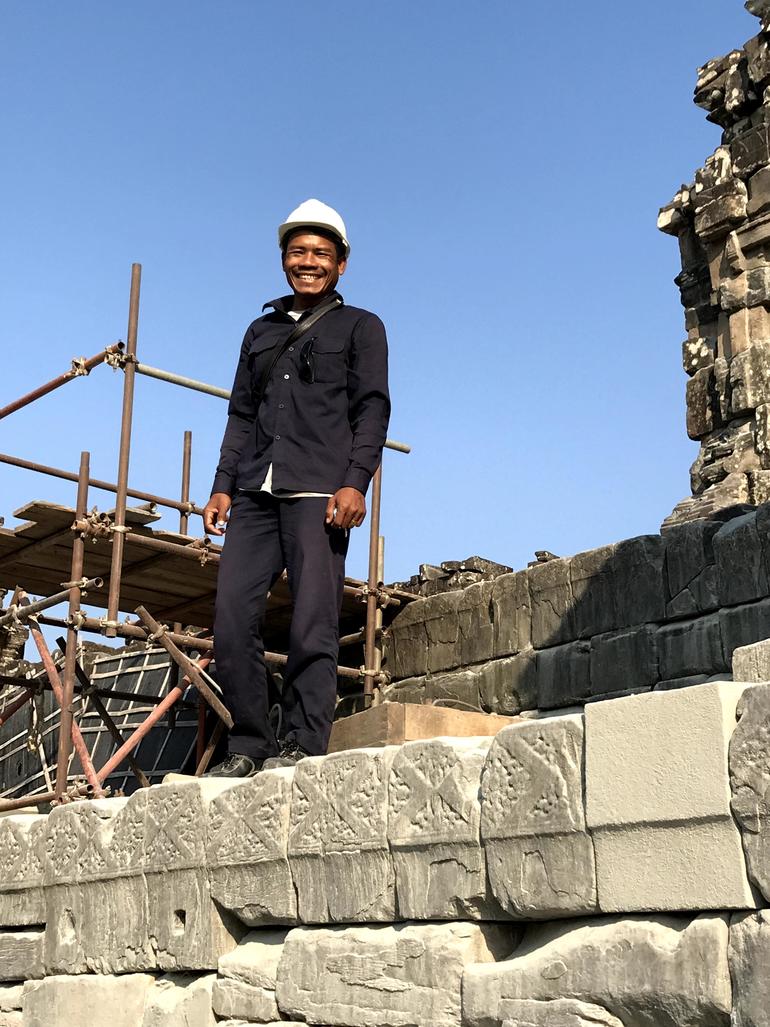
Mou Var, WMF’s Phnom Bakheng Site Superintendent.
After the ravages of civil war, a new generation of trained conservation professionals and craftspeople has emerged, nurtured by resources that World Monuments Funds supporters brought to the region. The major investments in knowledge-sharing, conservation planning, and technical skills that you have made possible have created a corps of Cambodian professionals who manage daily site activities and work in concert with international experts when new challenges arise.
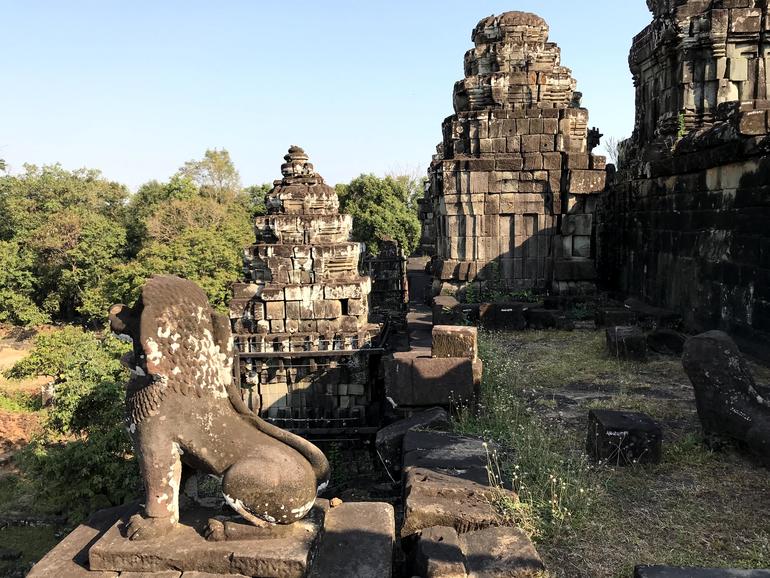
Untouched western half of Phnom Bakheng, currently being assessed by WMF.
Our Cambodian team is currently on track to complete the restoration of the eastern half of Phnom Bakheng at the end of 2019. As this work concludes, we will simultaneously assess the western half of the pyramid to determine a fitting approach to the completion of our work at Phnom Bakheng. I look forward to sharing continued updates with you about this profoundly meaningful and inspiring project.
Nearly 30 years of service to Angkor, thanks to you.
Our work in Angkor Archaeological Park is possible thanks to the leadership support of the US Embassy in Phnom Penh and the Ambassadors Fund for Cultural Preservation, The Robert W. Wilson Charitable Trust, Ralph E. Ogden Foundation, and Charities Aid Foundation of Canada. Additional contributions have come from hundreds of other generous individuals and institutions.
In 1996, Angkor Archaeological Park was listed on the inaugural World Monuments Watch—our flagship advocacy program for threatened sites of cultural heritage—thanks to the founding support of American Express.
Click below to learn more about how you can be a part of these extraordinary achievements.
Share
Previous
Next
